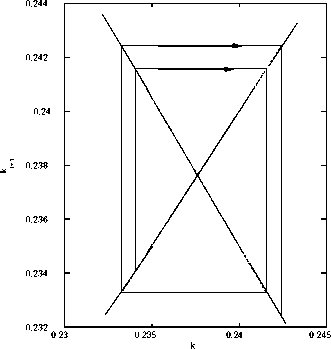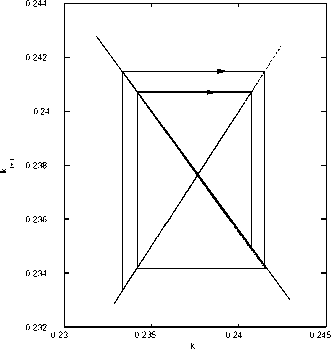Divergence Regime

Figure 4: The Evolution of Physical Capital in Convergence and Divergence
Regimes.
Convergence Regime

It is relatively straight forward to establish that as long as ψ > 1 the economy
does not settle down into a steady state. The reasoning is simple and assumes
first the opposite. If the economy were to settle into a steady state then at
some point the predictor would become relatively efficient and errors made with
the predictor and their variance would be arbitrarily close to zero. Therefore,
learning would become suboptimal and the quality of signal chosen would be
eventually zero, i.e., q2 = 0. However, with qj set to zero xt would follow a
divergent path and no rest point would be attained. Hence a contradiction. It
remains to establish that dynamic variables will not grow or keep diminishing
for ever, i.e., it needs to be shown that the lack of a steady state implies equilib-
rium oscillations. In economic terms variable xt+ι cannot grow for ever for its
growth requires on one hand high investment as xt+ι = 2ψ⅛t+ι ,i.e., future prof-
its are increasing in the productive capacity of the economy, and on the other
hand discourages investment as indicated by equation (32) high expected future
income leads to small savings. Similar argument applies to the case when xt+ι
where to keep falling. Technically, the eigenvalue in the system (??) is negative
hence the path the economy follows must be oscillatory.
In general the dynamic properties of the process followed by xt depend on the
magnitude of the coefficient preceding xt. For qt2 sufficiently high the coefficient
is necessarily less than one and xt converges to an equilibrium. On the other
hand if q2 is close to zero then the coefficient is higher than one and xt does not
converge to an equilibrium. Therefore, depending on the magnitude of qt2 the
economy follows either a divergent or a convergent path. Naturally, qt2 is chosen
in equilibrium and the equilibrium choice determines the characteristics of the
underlying equilibrium process. Observe that whenever the economy follows a
21
More intriguing information
1. The name is absent2. Workforce or Workfare?
3. The name is absent
4. Knowledge, Innovation and Agglomeration - regionalized multiple indicators and evidence from Brazil
5. Consumer Networks and Firm Reputation: A First Experimental Investigation
6. Can genetic algorithms explain experimental anomalies? An application to common property resources
7. Testing the Information Matrix Equality with Robust Estimators
8. WP 36 - Women's Preferences or Delineated Policies? The development or part-time work in the Netherlands, Germany and the United Kingdom
9. The name is absent
10. Sectoral specialisation in the EU a macroeconomic perspective